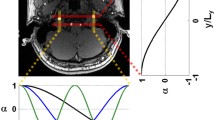Abstract
Dynamic imaging of the inflow of technetium-99m hexamethylpropylene amine oxime (HMPAO) to the brain has been proved to allow estimation of the hemispherical cerebral blood flow (CBF) using the Patlak plot. In this study, we compared the hemispherical CBF (in ml/min/100 g) of different patient groups. A total of 25 patients (comprising 13 with migraine and 12 scheduled for endarterectomy owing to angiographically confirmed severe stenosis of the internal carotid artery on at least one side) underwent baseline and acetazolamide 99mTc-HMPAO brain perfusion studies. In addition, acetazolamide 99mTc-HMPAO studies were performed in 12 healthy subjects (no baseline study was performed for ethical reasons.) Dynamic studies were acquired by means of a dual-detector gamma camera with a large field of view (HELIX, Elscint). Special difference images were created to make definition of the aortic arch and hemispherical brain regions easier and more reproducible. A semi-automatic method was developed to determine the transit time from the aorta to the brain, making the generation of the Patlak plot even more robust. The baseline CBF values did not significantly depend on the disease (P>0.1), whereas the CBF values obtained after acetazolamide provocation did do so (ANOVA, P<0.001). Patients suffering from migraine showed a significant increase in global CBF values after acetazolamide provocation (paired t test, P<0.05), but we could not find any effect of the provocation in patients awaiting carotid endarterectomy, indicating a lack of cerebrovascular reserve capacity. Comparison of the results of the acetazolamide study in patients and the control group revealed the CBF values to be significantly lower in patients with carotid stenosis (two-sample t-test, P<0.001), but not in those with migraine (P>0.1). In summary, using quantitative analysis of 99mTc-HMPAO brain studies we could objectively compare the CBF of patients suffering from different diseases. Especially the CBF values obtained after acetazolamide provocation permitted effective differentiation of disease states. The quantitative results may be of assistance in therapy planning, e.g. in selection of the correct operative technique.
Similar content being viewed by others
Author information
Authors and Affiliations
Corresponding author
Additional information
Received 29 June and in revised form 7 October 2001
Electronic Publication
Rights and permissions
About this article
Cite this article
Garai, I., Varga, J., Szomják, E. et al. Quantitative assessment of blood flow reserve using 99mTc-HMPAO in carotid stenosis. Eur J Nucl Med 29, 216–220 (2002). https://doi.org/10.1007/s00259-001-0688-y
Published:
Issue Date:
DOI: https://doi.org/10.1007/s00259-001-0688-y




